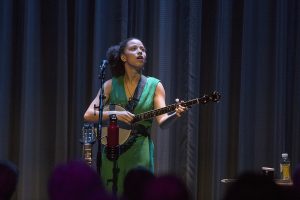Roller derby: The community under the helmets
Beyond the theatricality of roller derby matches lies a community of women building a space for themselves.
April 3, 2019
Wheels screeching by, a wall of powerful strong women fights to keep the opponents at bay as blood, sweat, and tears are spilled.
Roller derby is not a sport meant for the faint of heart, but the ones who stay with it find a second family in the community.
“I think it’s more of an intensity than it is an aggression,” said Hannah “Phineas Rage” Wyland, the coach of the Old Capitol City Roller Derby team and a University of Iowa graduate student. Having been a part of the sport for five years now, Wyland said she has no plans on quitting anytime soon.
“[I want to do it] as long as I can do it,” Wyland said. “I don’t ever want to quit. I get burnt out every once in a while, but then I go to a clinic, and I am on fire again.”
Roller derby is a sport most may have heard of, but it can be one that slips out of a list of top sports. Because of a recent resurgence, roller derby is stronger than ever.
“I think they think of ’70s roller derby, which was like WWE, where it used to be all staged,” Wyland said. “Then in Texas, it got restarted in the early 2000s, I think. It really had a neat rebirth recently.”
The rebirth has caused the sport to have clubs popping up all over the nation and globe. Old Capitol City follows the rules of Women’s International Flat Track Derby.
“We’re ranked internationally,” Wyland said. “We have an A team that’s ranked internationally and then as many B teams and home teams as you want. So our A team has to play three sanctioned bouts a year.”
The club is split into two teams, the A team “The All Stars” and the B team “The Ped Maulers.” The All Stars rank 106 out of 357 teams internationally, and both squads travel for competition and bouts.
Along with intense competition, roller derby has the goal of putting on a show. The history of theatricality is an aspect that it is trying to shed, but it can’t throw away aspects of its traditions that have now become part of the culture, Wyland said. Dramatic nicknames are an aspect of the old days that is still very much alive in this new-wave roller derby.
“I think it’s just a historical thing. It comes from the old days, and it’s fun,” Wyland said. “I think for some people, it gives them the opportunity to shed that other layer of themselves. To leave who they are at their day job behind. When they get to practice, they can be someone else — it gives them maybe a little bit more power.”
The nicknames aren’t random, though. Each is unique to represent the skater, and normally, it involves some pun-based tomfoolery.
“So I was a psych grad student when I moved to Iowa City, and Phineas Gage is a famous psych case,” Wyland said. “So I wanted a name that was going to reflect my psych degree, so that’s how I picked “Phineas Rage.”
Laura “BatR Up” Claps said the names are used throughout the game.
“It is weird to hear your teammates call you by your given name,” Claps said in an email to The Daily Iowan. “We usually approach each other or mid-game yell at each other with skater names.”
Derby member Emily “Ms. SMAC MAN” Woodbury earned her name for her love of video games and board games.

“I’ve spent many a night trying to get a higher score on Ms. PAC MAN, so Ms. SMAC MAN seemed like a natural fit,” Woodbury said. “Having an alter ego on the track is fun, and I love the way derby nicknames tell you something about each skater’s character or interests.”
The nickname is something that is a tradition for all players, but it must be earned.
“You want find one that’s unique,” Wyland said. “But we want you to be able to skate before you start telling us to start calling you by your chosen name. You have to earn it.”
Despite the names, costumes, and drama, roller derby isn’t all word play and theatrics.
“Though names, makeup, and bout-fits are fun,” said Megan “Peanut M&M” Miller, a blocker for the team. “[The] women taking the track are fantastic athletes looking for healthy and competitive play in adulthood, which roller derby certainly provides.”
Miller said that while it is a contact sport, it’s not a violent one — the goal is not to hurt the other team.
“I don’t know if there’s an aggressive mentality in roller derby,” Wyland said. “It’s just a willingness to just put it all out there. I wouldn’t say folks are aggressive on the track, some are serious, but a lot of the time people apologize if they think they hurt you.”
Roller derby is played in two 30-minute halves, in which five members of the team can battle on the track at once in an attempt to score points. Points are scored when the designated “jammer,” a player marked by a star on her helmet, passes the opposing team on the track. The jammer scores a point for each opposing member she can pass.
In such a contact support, players can earn time in the penalty box for breaking rules or for engaging in dangerous play, such as targeting another player’s head. Penalties typically last for 30 seconds of game play.
“Penalties are part of the game,” Wyland said. “The ones most think of are the blocker penalties — where you can and where you can’t hit somebody.”
Despite the competitive and physical intensity of the sport, the community and culture of roller derby is one of welcoming and inclusion.
“You get to be entirely you,” Wyland said. “You don’t have to hide in a female career or dress in a certain way. You can take off that gender and just do this sport you really love doing.”
This welcoming isn’t just about members of the female-identifying population, it welcomes all who seek the sport out.
“Roller derby is really good at being gender inclusive, too, for folks who are nonbinary,” Wyland said. “So whatever your identity, whatever you fall in that spectrum is cool with us. You can come in our community and be a part of it. I would say it’s more welcoming in that sense than other sports.”
The team has created a community that is not just about athleticism but also one with a deep sense of togetherness.
“I have gained an entire family of incredibly inspirational and hilarious women,” Miller said. “I’m continually amazed by what my teammates can do both on and off the track and am wowed by their compassion, strength, and abilities. I had hoped I’d at least get along with my teammates, but I didn’t expect for them to be such an incredible support and now some of my best friends.”
This kinship and community that this sport offers don’t end in Iowa City. With the derby association, there are clubs all over that will welcome all members with open arms.
“I think roller derby has more of a sense of community than any other sport,” Wyland said. “If you visit another city, you bring your gear because you can go to somebody else’s practice. And they genuinely want you to show up and interact. It’s nice to be part of something bigger, and I think roller derby has that in a much broader sense.”
Having this sport being such a women-dominated area, it is easy to see the power this sport has in the roles of gender in society.
“Roller derby is really cool because it’s grassroots, and it’s women doing this thing so we have a place,” Wyland said. “The [derby association]’s Board of Directors is all female, even down to the bottom. It’s mostly run by women. We’re creating a space for ourselves.”






